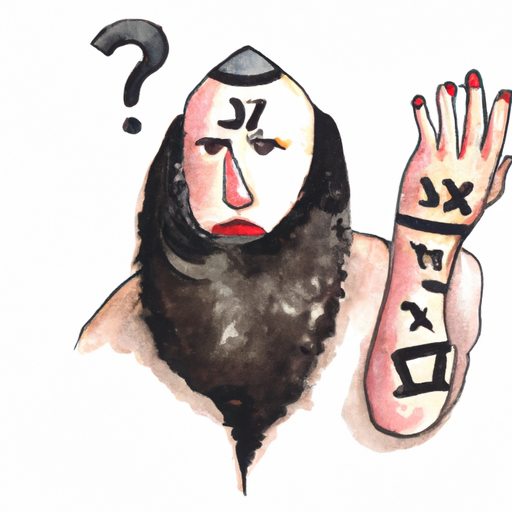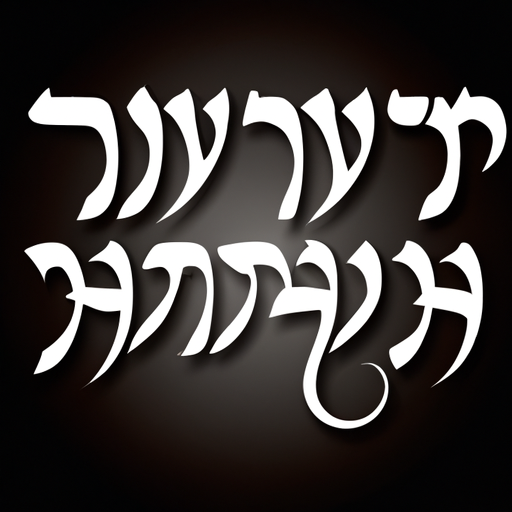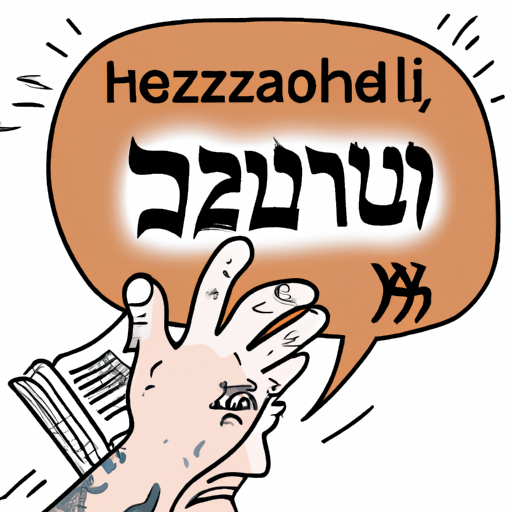Tattoos have long been a form of self-expression, personal identity, and even religious devotion. As more people embrace body art, the popularity of Hebrew tattoos has seen a steady rise. The ancient script and its deep-rooted religious and cultural significance make it an attractive choice for many tattoo enthusiasts. However, getting inked in a language that one does not understand or appreciate can lead to embarrassing and regrettable consequences, as evidenced by countless Hebrew tattoo mistakes that have gone viral online. In this article, we will delve into the world of Hebrew tattoos, exploring various aspects from the history and evolution of this body art to the controversies surrounding certain designs. We will also provide insights and cautionary tales to help you decide if a Hebrew tattoo is the right choice for you and, most importantly, how to avoid the dreaded lost-in-translation blunders. So, whether you are a tattoo aficionado, a Hebrew enthusiast, or simply curious about this unique form of self-expression, read on to discover the fascinating intricacies of Hebrew tattoos.
- 1. "Lost in Translation: Common Hebrew Tattoo Errors and How to Avoid Them"
- 2. "Inked and Educated: The History and Evolution of Hebrew Tattoos"
- 3. "Debating the Divine: Controversial Hebrew Tattoos and Their Significance"
1. "Lost in Translation: Common Hebrew Tattoo Errors and How to Avoid Them"

Lost in Translation: Common Hebrew Tattoo Errors and How to Avoid Them
Hebrew tattoos have gained popularity over the years, with many people choosing to express their identity, faith, or personal beliefs through this ancient language. However, the beauty and mystique of Hebrew can also lead to some unfortunate tattoo mistakes, resulting in embarrassing or even offensive body art. To help you avoid these blunders, we will discuss some common Hebrew tattoo errors and provide tips on how to prevent them.
1. Misspellings and incorrect letters: Hebrew is a complex language with its unique alphabet, and even slight alterations in a letter can change the meaning of a word. It is essential to consult with a Hebrew speaker or expert before getting a tattoo to avoid misspellings and incorrect letters.
2. Mistranslations: Directly translating words or phrases from one language to another can result in awkward or nonsensical expressions. To avoid this issue, try using an idiomatic expression or phrase with a similar meaning in Hebrew instead of a direct translation. Again, consulting with a Hebrew speaker or expert is crucial.
3. Inappropriate or offensive content: As with any language, some Hebrew words or phrases may have negative connotations or be considered offensive. Do thorough research and consult with a Hebrew speaker to ensure your chosen tattoo does not inadvertently convey an inappropriate message.
4. Incorrect word order: Hebrew is written and read from right to left, and the word order may differ from English or other languages. When designing a Hebrew tattoo, ensure the words are placed in the correct order and direction to avoid confusion or misinterpretation.
5. Stylization issues: While it might be tempting to get a Hebrew tattoo in a stylish or decorative font, this can sometimes lead to illegibility or distortion of the letters. Stick to simple, clear fonts to ensure the accuracy and legibility of your tattoo.
To avoid these common Hebrew tattoo errors, follow these tips:
– Consult with a Hebrew speaker or expert to ensure the accuracy of your chosen design.
– Do thorough research on the meaning and cultural context of your chosen phrase or word.
– Consider using an idiomatic expression with a similar meaning instead of a direct translation.
– Ensure the correct word order and direction are used in the design.
– Opt for a simple, clear font to avoid illegibility or distortion.
By taking these precautions, you can significantly reduce the risk of Hebrew tattoo mistakes and ensure your body art is a meaningful and beautiful representation of your chosen sentiment.
2. "Inked and Educated: The History and Evolution of Hebrew Tattoos"

Hebrew tattoos have a rich history that dates back centuries, reflecting not only the evolution of tattoo art but also the cultural significance and meanings behind Hebrew symbols and letters. As tattoos gained popularity in modern society, so too did the trend of incorporating Hebrew script into body art.
The early history of Hebrew tattoos is somewhat unclear, as the Jewish faith traditionally forbids tattooing, based on the Leviticus 19:28 verse that states, "You shall not make gashes in your flesh for the dead, or incise any marks on yourselves: I am the Lord." Despite this religious prohibition, some Jews still chose to get tattoos throughout history, often as an act of rebellion or as a way to express their identity and faith.
One of the most poignant and well-known examples of Hebrew tattoos comes from Holocaust survivors, who were forcibly tattooed with identification numbers by the Nazis. Following World War II, these tattoos became a symbol of endurance and defiance against the atrocities committed during the Holocaust. Some survivors and their descendants have chosen to incorporate these numbers into their own tattoos as a tribute to their family’s history and resilience.
As tattooing became more mainstream in Western culture, Hebrew tattoos gained popularity among both Jews and non-Jews alike. Many people are drawn to the beauty and mystique of Hebrew script, which can create unique and meaningful tattoos. Additionally, the Hebrew language has a strong connection to spirituality and the divine, making it a popular choice for those seeking to express their faith or beliefs through body art.
Hebrew tattoos have evolved over the years, incorporating various styles and techniques. Some popular Hebrew tattoo designs include the Star of David, the Hamsa (a protective amulet), and Hebrew phrases or verses from religious texts, such as the Torah or the Kabbalah. Many people also choose to get their names or the names of loved ones tattooed in Hebrew script.
However, the evolution of Hebrew tattoos has not been without its challenges. The rise in popularity of Hebrew tattoos has also led to an increase in mistakes and mistranslations, often due to a lack of understanding of the Hebrew language and alphabet. Hebrew is a complex language with a unique script, and it is easy for those unfamiliar with it to make errors, leading to tattoos with incorrect or nonsensical meanings. This has led to the creation of resources like the "Bad Hebrew Tattoos" blog, which highlights and educates about these common mistakes.
In recent years, there has also been an increase in controversial Hebrew tattoos, often involving religious symbols or phrases that may be considered offensive or inappropriate. These tattoos can spark debate and discussion about the role of tattoos in expressing one’s faith and the responsibility of the tattoo artist and wearer to ensure that the chosen design is respectful and accurate.
Overall, the history and evolution of Hebrew tattoos reflect the rich cultural and spiritual significance of the Hebrew language and its symbols. As Hebrew tattoos continue to evolve, it is essential for those considering getting one to educate themselves on the language, history, and meaning behind their chosen design to avoid mistakes and create a beautiful, meaningful piece of body art.
3. "Debating the Divine: Controversial Hebrew Tattoos and Their Significance"

The allure of Hebrew tattoos for many people lies in the language’s ancient roots, deep symbolism, and cultural significance. However, this fascination with Hebrew tattoos can sometimes lead to controversial designs and meanings. In this section, we will explore some of the most debated Hebrew tattoos and discuss their significance.
1. God’s Name: One of the most controversial Hebrew tattoos is the use of the Tetragrammaton, the four-letter Hebrew name of God (יהוה), often referred to as YHWH or Yahweh. In Jewish tradition, God’s name is considered sacred and should not be written or pronounced casually. As a result, using the Tetragrammaton in a tattoo can be seen as highly disrespectful and offensive. Some individuals may choose to ink this design as a sign of their devotion to God, but it is essential to understand the cultural implications and potential backlash from the Jewish community.
2. Holocaust Imagery: Another controversial subject matter for Hebrew tattoos is the use of Holocaust-related imagery or phrases. The Holocaust was a horrific event in Jewish history, and it is considered highly insensitive to use its symbols or words in a casual manner. For example, getting a tattoo of a concentration camp’s identification number or the phrase "Arbeit Macht Frei" (Work Sets You Free), which was displayed at the entrance of Auschwitz, can be seen as offensive and trivializing the suffering of millions. If you want to honor the memory of the Holocaust, it is crucial to do so with respect and sensitivity, avoiding such controversial tattoos.
3. Kabbalistic Symbols: Kabbalah is a form of Jewish mysticism that has gained popularity in recent years, particularly among celebrities. This interest has led to an increase in tattoos featuring Kabbalistic symbols and phrases, which can be controversial for several reasons. Firstly, these symbols and texts often have deep, esoteric meanings that can be easily misunderstood or misrepresented. Secondly, Kabbalah is a complex and sacred aspect of Jewish spirituality, and using its symbols as mere fashion statements can be seen as disrespectful. If you are drawn to Kabbalistic imagery, it is essential to research its meaning thoroughly and consider the implications of wearing such a symbol on your body permanently.
In conclusion, it is crucial to approach the decision to get a Hebrew tattoo with caution and respect for the culture and history behind it. Controversial tattoos, such as those featuring God’s name, Holocaust imagery, or Kabbalistic symbols, can lead to backlash and offense. Before committing to a design, research its significance, consult with knowledgeable sources, and consider the potential consequences of your choice. Ultimately, a Hebrew tattoo should be a meaningful and respectful expression of your identity or beliefs, not a source of controversy or misunderstanding.
In conclusion, Hebrew tattoos have a rich history and continue to evolve as a popular form of self-expression. However, as we have discussed, there are many potential pitfalls when it comes to getting a tattoo in a language one is not familiar with. From translation errors to controversial meanings, it is essential for individuals considering a Hebrew tattoo to do their research and consult with knowledgeable sources to ensure their ink accurately reflects their intended message. Additionally, it is important to be aware of the cultural and religious significance that may be associated with certain Hebrew tattoos and to approach the decision with respect and understanding. Ultimately, a well-executed Hebrew tattoo can be a powerful and meaningful form of self-expression, but it is essential to tread carefully and thoughtfully on this journey.